BMP-2 mRNA-transfected BMSCs promote superior calvarial bone regeneration
- PMID: 40301548
- PMCID: PMC12041208
- DOI: 10.1038/s41598-025-99979-6
BMP-2 mRNA-transfected BMSCs promote superior calvarial bone regeneration
Abstract
Large critical-size bone defects in the oral and craniofacial region are difficult to regenerate. We evaluated the effectiveness of mRNA encoding bone morphogenic protein-2 (BMP-2) in enhancing bone regeneration using a rat calvarial defect model. Two delivery approaches were investigated: (1) in vivo application of BMP-2 mRNA encapsulated in lipid nanoparticles incorporated in a scaffold, and (2) application of ex vivo BMP-2 mRNA-transfected rat bone marrow mesenchymal stem cells (rBMSCs), loaded on a scaffold and implanted into calvarial defects. The direct application of BMP-2 mRNA encapsulated in lipid nanoparticles improved bone regeneration as indicated by micro-computed tomography analysis. The enhancement was even more pronounced with ex vivo transfected rBMSCs. rBMSCs transfected with FGF-2 mRNA did not improve bone regeneration, either alone or combined with BMP-2 mRNA-transfected rBMSCs. Similarly, PDGF-BB mRNA-transfected rBMSCs failed to enhance bone regeneration alone and notably suppressed BMP-2 mRNA-transfected rBMSCs' effects. Interestingly, BMP-2 mRNA-transfected rat fibroblasts showed comparable bone regeneration to transfected rBMSCs. Osteogenic differentiation was absent in BMP-2 mRNA-transfected rBMSCs, implying that they may primarily serve as a source of translated BMP-2 for bone regeneration rather than undergoing osteogenic differentiation. These findings highlight the translational potential of BMP-2 mRNA for bone regeneration, particularly in oral and craniofacial applications.
© 2025. The Author(s).
Conflict of interest statement
Declarations. Competing interests: The authors declare no competing interests.
Figures
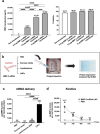
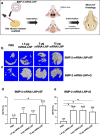
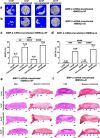
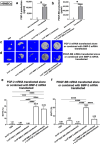
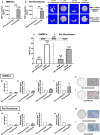

Similar articles
-
Collagen-infilled 3D printed scaffolds loaded with miR-148b-transfected bone marrow stem cells improve calvarial bone regeneration in rats.Mater Sci Eng C Mater Biol Appl. 2019 Dec;105:110128. doi: 10.1016/j.msec.2019.110128. Epub 2019 Aug 24. Mater Sci Eng C Mater Biol Appl. 2019. PMID: 31546389 Free PMC article.
-
Dual delivery of rhPDGF-BB and bone marrow mesenchymal stromal cells expressing the BMP2 gene enhance bone formation in a critical-sized defect model.Tissue Eng Part A. 2013 Nov;19(21-22):2495-505. doi: 10.1089/ten.tea.2012.0648. Epub 2013 Jul 31. Tissue Eng Part A. 2013. PMID: 23901900 Free PMC article.
-
BMP-2 gene transfection of bone marrow stromal cells to induce osteoblastic differentiation in a rat calvarial defect model.Mater Sci Eng C Mater Biol Appl. 2018 Oct 1;91:806-816. doi: 10.1016/j.msec.2018.06.004. Epub 2018 Jun 12. Mater Sci Eng C Mater Biol Appl. 2018. PMID: 30033316
-
Calcitonin gene related peptide gene-modified rat bone mesenchymal stem cells are effective seed cells in tissue engineering to repair skull defects.Histol Histopathol. 2019 Nov;34(11):1229-1241. doi: 10.14670/HH-18-102. Epub 2019 Mar 21. Histol Histopathol. 2019. PMID: 30896037
-
Engineering biomimetic periosteum with β-TCP scaffolds to promote bone formation in calvarial defects of rats.Stem Cell Res Ther. 2017 Jun 5;8(1):134. doi: 10.1186/s13287-017-0592-4. Stem Cell Res Ther. 2017. PMID: 28583167 Free PMC article.
Cited by
-
Identification and Characterization of the Complete Genome of the TGF-β Gene Family in Tupaia belangeri: Expression and Function of Adipose Tissue Under Cold Acclimation Conditions.Int J Mol Sci. 2025 Jul 11;26(14):6681. doi: 10.3390/ijms26146681. Int J Mol Sci. 2025. PMID: 40724931 Free PMC article.
-
The Effect of Rosavin, a Characteristic Compound of Rhodiola rosea, on BMP-2 Induction and Osteoblast Proliferation In Vitro.Int J Mol Sci. 2025 Jun 24;26(13):6075. doi: 10.3390/ijms26136075. Int J Mol Sci. 2025. PMID: 40649853 Free PMC article.
References
-
- Wikesjö, U. M., Huang, Y. H., Polimeni, G. & Qahash, M. Bone morphogenetic proteins: a realistic alternative to bone grafting for alveolar reconstruction. Oral Maxillofac. Surg. Clin. North. Am.19, 535–551, vi-vii (2007). - PubMed
-
- Fiorellini, J. P. et al. Randomized study evaluating recombinant human bone morphogenetic protein-2 for extraction socket augmentation. J. Periodontol. 76, 605–613 (2005). - PubMed
MeSH terms
Substances
Grants and funding
LinkOut - more resources
Full Text Sources

